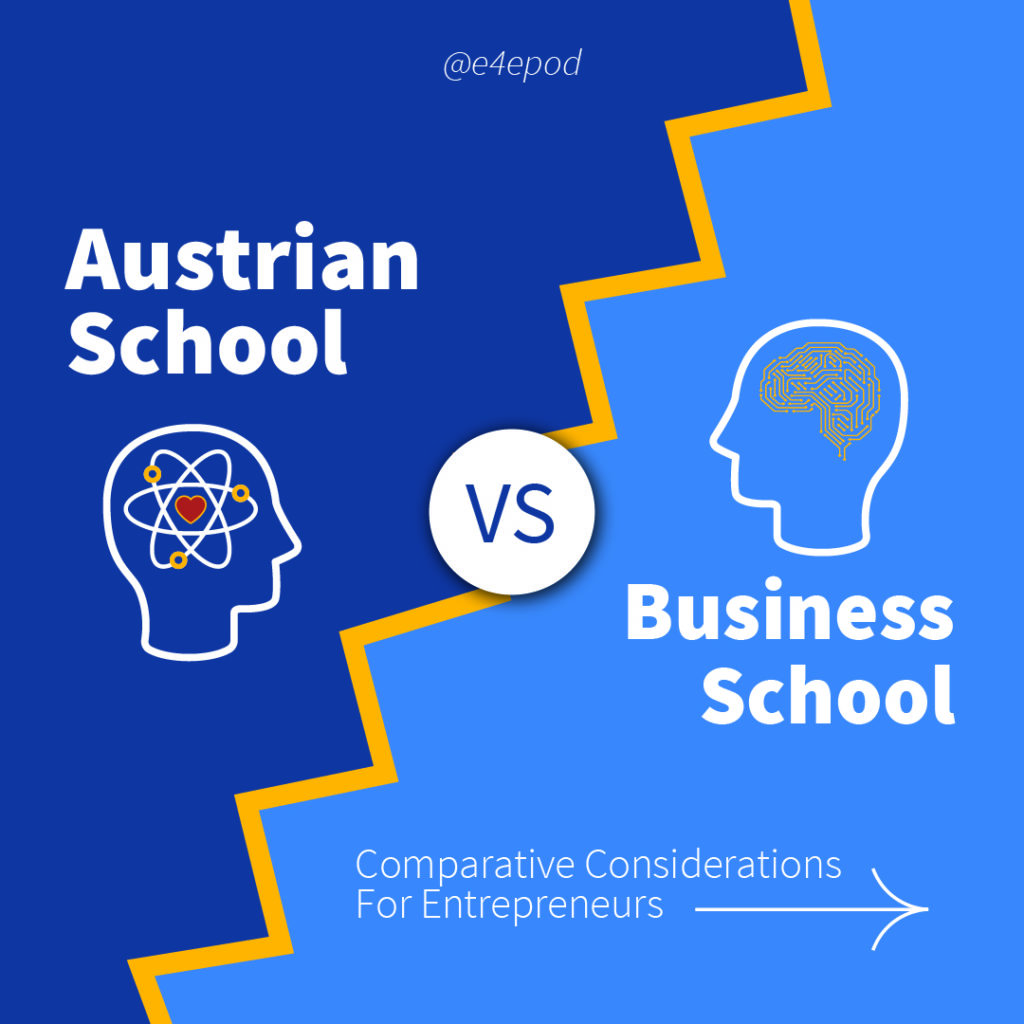Per Bylund Introduces The Austrian Business Model.

Podcast Transcript: Conversation With Economist Dr. Per Bylund; August 11, 2020
Listen to the full episode here.
Hunter:
Per, welcome again to Economics for Entrepreneurs.
Per:
Thanks for having me on again, Hunter.
Hunter:
You’re very generous in the consulting help that you give to entrepreneurs and all kinds of businesses and in your student teaching, so you’re shaping the next generation of business leaders and innovators and you gave two presentations at Mises University 2020. We’ll highlight some of the content today and we’ll link to those lectures on YouTube, which are accessible to everybody. One was called Austrian Economics and Business, and the second one was How Entrepreneurs Built the World. We’ll cover the essence of both of them today, but I’m going to start by laying out a proposition that it sounds to me like you’re putting the final touches to something we can call the Austrian Business Model. Is that correct?
Per:
I think so. That’s a pretty accurate way of putting it, I think. I mean, what I did in my lecture was basically talk about how first mainstream economics is not very helpful for businesses and business owners and those starting new businesses. Even though there is a subject and usually a course called Managerial Economics, what you learn there is simply to maximize curves and to put marginal revenue equal to marginal cost and things like that, and when you don’t really have those numbers and you don’t have equations in your business it’s not very helpful at all.
Per:
And then economics tends to not look inside the black box that is the firm, they just assume that there are firms. So it’s not strange that it’s not very helpful, but Austrian economics is different. We look at human beings and human action, and that is what is going on within a business and their businesses in a sense of organized action towards a specific end and the businesses try to satisfy their customers. And how do you do that? Well, we have plenty of answers to that in Austrian economics.
Per:
So an Austrian Business Model would simply be a way of structuring your business and following guidelines to make sure that you avoid errors and mistakes.
Hunter:
Good. So we could call a business model applied theory, applied theory to generate what you called in one of your lectures unceasing innovation and improvement at the level of the firm on behalf of the customer, obviously. We could call it process logic for continuous and sustainable value generation which then results in revenue generation and profit for the firm.
Hunter:
One of the interesting things in your lecture was you said that experienced entrepreneurs are generally Austrian even if they don’t know it and successful businesses are Austrian by definition. So the Austrian Business Model works, you would say.
Per:
Yeah, exactly. And what I mean by that is simply what I’ve learned from experience that talking to experienced entrepreneurs they have learned how the economy works, how the market economy works, and they have learned how to avoid the common mistakes and how to structure your business so that you have the greatest chance of survival. And the way they’re doing that is pretty much the same thing as we do in Austrian economics, but we do it in terms of theories. So we generalize it and we have general ideas and rules in a sense for how the economy works. Well, by applying those we can help businesses succeed to a much greater extent. And there’s, of course, a golden opportunity here because you have all these experienced entrepreneurs and business leaders who have this gut feel or this intuition that they’ve generated through just accumulating experience, but they don’t really have a terminology or words for it. They don’t have it well formulated, but we do in Austrian economics. We have the theory so we can provide them with this language and such things as putting the customer first, that value is subjective and what that means, the implications for the business, and so forth. So there’s a lot that we can really learn from each other, both practitioners and Austrian theorists.
Hunter:
Good. That’s exactly what we’re trying to do here. The place to start, you’ve mentioned it already, but it strikes me that it represents one of the true differences of applying Austrian economics in businesses, this understanding of value as subjective, and it creates a very different perspective on value because it takes place in the mind of the customer. It’s an experience of the customer, so that the true locus of value generation is in the customer’s domain when they use an experience the entrepreneur is offering.
Hunter:
So let’s start there. What are the business model implications for entrepreneurs of subjective value?
Per:
Well, that’s what we said. I mean, value is really created in consumption, so it’s only in the use of a product or service that you actually get the value from it. That’s why we consistently talk about not entrepreneurship as value creation, but it’s value facilitation. So the only thing you can do as an entrepreneur is to provide a good or an experience to a customer, and then what the customer makes of it is really out of your hands. You can’t really do much about it. What you can do is sort of nudge the customer in one direction or the other and try to help them figure out that there is something valuable to them on their own terms from using your product. But that’s all you can do. So value in that sense is personal and it’s subjective, so you can’t really put it in any type of objective measurement.
Per:
So we talk about profit in dollars, for instance, but the value of having something is it’s not… You can’t express that in dollars. You can’t express that in anything else and mainstream economists, when they teach these things they talk about utiles as a sort of measurement of utility you get from something. I mean, it’s like having a fancy meal with a loved one in a restaurant, for instance. I mean, if you get great service and a great meal and a great atmosphere and everything, the whole package there, what is that worth to you? Well, it’s worth to you… The whole experience is worth some degree… You get a good feeling inside, and you have a memory that you can live off for a very long time and so forth. Of course, you might be able to pay a certain dollar amount for it, but the value to you is your experience. It’s really nothing else.
Per:
So we have to understand this when we run a business, when we start a business, and when we study businesses, too, that what you’re doing is trying to help them get the best experience possible. So the customers should experience something that they value on their own terms, whether or not they can actually put the actual words on it.
Hunter:
Right, and that’s something that tends to be neglected in business school and their models, which are very mathematical. They look at things objectively, they try to engineer the results in terms of numbers, and they miss that subjective value description that you’ve just so eloquently made.
Hunter:
So we start the model there, and then you mentioned that we help the entrepreneur think about understanding the customer and their subjective value, and then they can create a value proposition. So let’s describe what a value proposition is in the Austrian Business Model.
Per:
Well, sure. It’s the complete offering. It’s the complete experience that the customer gets out of what it is you’re offering. And there are many, many ways you can tweak this, of course, but how do you tweak it? Well, the only way of doing this is to know who the customer is to begin with, and it includes all aspects of what it is you’re offering. It’s a time and place, and it’s the price, and it’s the type of language used just introducing it. It’s the actual quality of the thing or the service, and it’s how you follow up on it and how you treat your customer. And all of these things are really part of it. And whether it’s valuable or not, that’s completely in the customer’s own eyes.
Hunter:
Yeah. And this picture of the, I call it the longitudinal multifaceted variable of the experience. It’s really complex. You’ve also mentioned that to think of it through the customer’s eyes, it’s always relative. They’re always thinking, “Well, where else could I get a better experience?”, and it’s always comparative: “What else could I spend the same amount of dollars on?” So the entrepreneur is always going to be thinking about those two elements of the experience, relative and comparative.
Per:
Exactly. And that’s where you try to find your own niche as an entrepreneur and try to provide something unique that is really, really valuable to a certain subset of the market. I mean, in mainstream business, and we talk about market segments and so forth and you’re supposed to find your beachhead market and all of these things, but it’s really important that you really understand the customer and what type of experience they might enjoy and that they might get extra value from. It might be a really, really narrow one or it might be a broad one, and depending on what you want to do as an entrepreneur and how you think that you can get the most value out of it for yourself and provide [inaudible 00:10:35] value, you might choose one that is really specific for just a few customers, but really valuable to them, or you can provide something that is sort of general and not super valuable to anyone where you rather compete on price. But what you are selling is always the complete experience. So if you’re doing something, let’s call it shallow. I mean, this doesn’t sound all that good, but if you have a shallow offering, meaning that basically you just sell stuff and you don’t provide a whole lot of additional experience, no fluff, you don’t provide an experience.
Per:
So any type of retail would be this type of business, like a Walmart or something like that. You don’t go to Walmart because of the experience. You don’t consider paying extra when you go to Walmart because you get special treatment or you get superb customer service or anything like that. You’re just interested in getting the product and getting out of there. That’s basically what you’re doing. So they’re catering to a lot of people who are price sensitive, but they’re not treating you as king, as I said, customer, whereas in other more highly priced retail stores or grocery stores, they might greet you in a different way. They might have music on and all these things, but you’re also paying for it. But it’s a much more narrow market segment, where this segment specifically really value that it is super clean, that they always have a certain number of each product available, that they only have products of a certain quality or a certain brand or whatever it might be. And everything that is part of this experience is part of what you’re selling. So for Walmart it’s keep prices low, but don’t give anything extra like that. But for other goods, pricing might be part of the thing or it might be part of the offering.
Per:
So luxury sports cars, for instance, or yachts or something like that, they might sell those for a price that is really ridiculously high not simply because the cost of production is high because the cost of production might not be high, but because it excludes those who are not rich enough and thereby makes the product much more valuable to those who can afford it. And so the price itself can be part of the experience and part of the good that they’re offering.
Hunter:
Yeah. I think of places like Louis Vuitton stores, which my wife occasionally takes me to, and that’s a totally different experience than Walmart. The prices are extremely high. There’s very little inventory, but the decor of the store is meticulously designed and the members of the staff, of which there are many, are highly, highly trained. They treat you like you’re a member of the elite, and it’s an experience itself. Even if you don’t buy there, it says something about the Louis Vuitton brand. So those are kind of the two ends of the spectrum that you’re talking about.
Per:
Yeah, exactly. That is an interesting example, too, because it’s so obvious that they are catering to one of the two entering. So when you and your wife enter, they might cater to her as the person who gets the experience and makes the decision to buy, but not as much to you even though you might be the one writing the check, right? So you need to know as a business owner what type of customer will I target and what is the actual value to them? Is it usually a couple where one has the income and the other makes the purchases or is it a different constellation? You need to know these things because that’s how you position your offering and how you… You mentioned the decor in the store and things like that, how this works, how it looks, how it feels for the customer. The whole experience is really important.
Hunter:
Right. And it highlights another point you always make, Per, that in designing these value propositions and delivering them, the two firms aren’t competitive. It’s possible that you can buy handbags in Walmart but Walmart and Louis Vuitton, while they’re both retailers and they’re both selling handbags, they’re not competing. They’re designing totally unique value propositions for different people at different times in different states of demand. So we don’t think so much of firms competing with each other as firms designing unique experiences.
Per:
Yeah, exactly. That’s exactly what they’re doing.
Hunter:
Good. So we’ve mentioned another element which is different in the Austrian Business Model and that’s pricing, and this is fundamental and you covered it in your lecture where we’re taught traditionally in the business school to think about cost plus pricing. We’ve mentioned it before in the podcast, but let’s cover it again in the sense that that’s the wrong way to think about it, that the customer decides what the price is that they’re willing to pay for the experience you’re offering and then the entrepreneur chooses the price. Can you go over that again for us because it’s really important?
Per:
Yeah. Yeah. I would love to. And you mentioned the cost plus method of pricing and this is sort of one of my pet peeves, and I really, really hate that concept. It’s actually a good reason to not get an MBA at all because they teach that stuff. It really balances out any type of value you might get from any of the other courses because they teach you this BS, really. So I mean, the way to think about it is that when you start a business or when you pivot a business, you need to figure out who the customer is, which we already talked about, and how valuable the experience might be to this customer. From there, you can guesstimate a price that they will be willing to pay for this. And this probably shouldn’t be as much as possible as we often teach it and as economic models suggest. It should be a price that helps you sell the product.
Per:
We already talked about how the price is part of the offering, right? So the price could be really high if that adds to the product, or the price should at least be much lower than the value for the consumer. So the consumer… Well, of course, as you already mentioned, look at the balance, the trade off, okay? What type of value do I think I get from this company for this money compared to what they can get for my money elsewhere? And that’s perfectly subjective from their own point of view, and the entrepreneur needs to figure out what type of price is the best price for my niche or for my market segment, for my preferred customers. And then from that price, you need to figure out how am I supposed to produce something that gives them this experience, this value, where I can still keep my costs per unit produced lower than the price that I can charge for this. So in a sense, the only thing you can do as an entrepreneur is to choose the cost structure of your business. You don’t do anything else.
Per:
If you figure out who the customer is, because you already have an idea of what you want to produce and what you’re good at, perhaps, or what type of market do you want to be in and all of those things, but when you have figured out who to cater to, who is your customer, then it’s pretty straightforward in a sense that what makes these customers find real value in the experience. Well, that’s where you need to go. And then that gives you an indication of what price they’re willing to pay, and your job is to get them the experience at a cost that is lower in price. And, of course, the difference between those two, that’s your profit.
Hunter:
Yep. And there’s a surprising implication of that, Per, which you covered at Mises University 2020, which is to make those costs, to assemble the cost structure that they want, the best thing for the entrepreneur to do is rely on market prices, which means buying the components, the resources outside of the firm, and then just focusing on inside the firm the things that only that firm can do uniquely. So you got to make it inside, and that has huge implications for organizational design. So take us through that use of market prices for us, please.
Per:
Right. So one way that I think a lot of entrepreneurs… It’s a mistake that they make is that do you want to control everything? You want to make sure that you have things in house, because if something happens then you need to be able to just redirect resources or make sure that you have this guy on the staff so that you can use them more or whatever it is. And we all feel this, and this is sort of a human instinct to whenever something is uncertain we go for control. Well, control is pretty worthless. When you’re dealing with value generation and trying to create an experience of value to others, you will do this under uncertainty. There is no other way. And control is pretty worthless in this case. What you need to do is figure out how can you contribute as much as possible to whoever is on the other end; that is, your customer. So what you need to do is bear that uncertainty and make sure that you are focusing on where you contribute to value.
Per:
So the implication of this is to keep as little as possible in house. And this sounds counterintuitive simply because you want to control as many bits and pieces as possible so that you don’t stand at the end with only half a product or can’t complete your production and you can’t offer the customer everything that you wanted and so forth. But the thing is that the market has this fantastic mechanism for allocating resources toward the greater benefit for consumers, and it’s the price mechanism. And it sounds like very abstract economic theory and it is, but if you apply it what this means is that the more stuff in your business you can put on others and thereby contract them out, you outsource to others who are experts in those areas, the easier it is for you to focus on your core contribution. And today, most startups you wouldn’t hire an accountant. You also wouldn’t hire an IT guy. That’s not the first thing you do because this just seems like a waste of money. But if you really want to be in control of your books, if you really want to be in control of your technology, that’s where you should go. But now it’s become so obvious to all businesses that no, you’ll have an accountant and you just send your receipts that way and they take care of it, right? And the same thing was with IT.
Per:
You can buy consultant hours or you can buy services from there, and you might even get some service with the hardware when you buy it and things like that. That’s the way to think about your business, and that means that you don’t have to… The more you outsource you don’t have to struggle with or deal with potential problems with all those parts because you have already outsourced those problems in a sense to others and you’re just paying the bill.
Hunter:
Yeah. And it seems like today, the world is catching up with that kind of applied Austrian theory because the interconnectivity that you can get through the internet to global supply chains and other kinds of suppliers and buying in resources that others have made, and so on. That’s very contemporary, so Austrian economics was ahead and will keep ahead with this business model of new thinking about organizational design.
Per:
Yeah. And it’s really fantastic when you have a really good theory that is universally applicable and it’s not really sensitive to different times of civilization or the market or the economy or the world, of course, but it always applies. It is held in very general seemingly abstract terms, but it should be always applicable. And then that’s the case with Austrian economics, and that’s why [inaudible 00:24:14], like you said, it’s valuable to apply it over and over again because it provides insights into any of these situations even if the situations are different.
Hunter:
Yep. And technology enables more and more application, right? If that’s the right way to say it. The internet wasn’t around when Carl Menger wrote his principles, but today you can apply them in an internet-powered world.
Per:
Oh, exactly. And I mean, the more information and communication technology we have the closer we all are, meaning that we can outsource more and more, meaning that we can do less and less and focus more and more narrowly on our value contribution.
Hunter:
Which brings us to the next point. It’s overlapping, but it’s about Austrian capital theory which says that your capital structure should reflect the way in which you best serve the customer, and the assets that do that will be the ones that generate your customer revenue, and you should be constantly inspecting them and perhaps changing them up as customer preferences change. So you got to examine your assembly of assets and keep inside the ones that are most contributing to customer service. Is that the right way to think about it?
Per:
Yes, it is. And I mean the way you use resources right now, you bought them for a reason, you put them in place for a reason, and so forth, so the best approach to adopt an Austrian Business Model when you’re already up and running a business is to think about it probably in terms of investing and divesting. So when you’re buying new, if it’s machinery or computers or moving to a new location, whatever it is, all of these investments, you should think as an Austrian would think of the customer first. How does this contribute to the consumer’s value experience and can I do this differently so that I contribute even more to the consumers’ value experience? Because if you can change up your business by investing in different types of capital, which just means any type of resources but basically [inaudible 00:26:33] labor and you can enhance the consumer’s experience by doing this, it’s not impossible to raise the price. You can very easily sell your product, let’s say, and it’s a next-generation enhanced type of product so you can raise the price there, but you should always direct everything using your own customer, that targets customer, as your guiding star. That’s where you should always direct everything you do by that person’s value experience.
Hunter:
Right. And just one last point on that, Per. The other thing that strikes me that Austrian economic theory makes us think about is the dynamics of the economic situation, and there’s no equilibrium. Things are always changing, and the entrepreneur and the firm that they’ve set up need to be set up for those dynamics. Everything is going to change all the time, your competitor, your consumer, your environment, and so setting up for dynamics is one of the pieces of direction that Austrian economics can help with.
Per:
Absolutely. I mean, it’s important to be agile and be flexible and be able to adjust to changing circumstances, and it’s your job as an entrepreneur to figure out what those changes might be. So it might not be wise probably ever to maximize resource usage at any point in time. Sometimes you might need to do that in order to satisfy your customers but maybe temporarily, but it’s often a good idea to have additional resources, have a plan for pivoting your business because you expect something to happen. So as an entrepreneur, you should always think ahead and think of how can I satisfy customers in a better way. That’s your job as an entrepreneur. You’re not supposed to run the business as much as figure out how this business can satisfy the consumer in a better and better way.
Hunter:
Yeah. I recall Jeff Bezos at Amazon saying that now his job is thinking three to five years ahead and leave the everyday execution of the business model to others.
Per:
Exactly. And I mean in Austrian economics, we distinguish very clearly between the roles of the entrepreneur and the roles of the manager. It doesn’t mean that you as an entrepreneur has to do only the entrepreneurial things and you should never manage. It could be the same person, but those are two different roles with two different purposes and two different goals that they’re trying to achieve.
Hunter:
So let me sum up the elements of the business model that we’ve covered, and then perhaps I can ask you to summarize the implications for business people and entrepreneurs.
Hunter:
So we’ve said that the model is distinctive in its understanding of value, in helping entrepreneurs construct a value proposition, to design a production capability that delivers that value proposition. We recognize that values and experience and delivering end to end completely in depth that extended experience. We’ve got a differentiated understanding of pricing. That cost is an entrepreneur’s choice after the customer has chosen the price, and we’ve talked about the implications for organizational design and embracing and managing for change. So we’ve got the elements of a model. Let’s have you talk about the implications for people in business from this new way of looking at things.
Per:
One is to always think about the customer and then really be obsessed with the customer. Another is in entrepreneurial terms to think of how can you best serve the customer, and that should be a decision for the whole business and, of course, all the parts, too, but the whole business. Can this business and all those investments made in this business serve customers in a better way doing something else? Well, then you should probably pivot the whole business even if you are in a profitable situation, even if you have a reputation, and so forth. If you can do something much better elsewhere, if you can do something much better for a different customer segment, whatever it is, maybe you should consider doing that. And that’s sort of the role of the entrepreneur in the whole market system is to direct resources to the better value experience for customers.
Per:
So it’s really your job as an entrepreneur to do this, to figure out how to best serve consumers overall by figuring out which consumer do you with your special skills and expertise can satisfy in the best way possible. And then in the business, of course, when you have already established what the business’s goal is and how the business satisfies consumers, then you have management of this sort of collection of resources and employees. And in that business, the role of management is really to try to strengthen the value proposition, trying to tweak it one way or the other, trying to tweak all the parts, figure out some changes here and there, make some adjustments in order to make sure that what you’re offering is as highly valued as possible. It’s not really about pivoting the business anymore when you’re doing it.
Per:
So the role of the manager is really to take the idea from the entrepreneur and try to make as much as possible out of it. And of course, part of this is efficiency, trying to operate as efficiently as possible. Don’t use any resources that you don’t actually need, don’t have any waste, [inaudible 00:32:52] cut that off, don’t have extra overhead. And those sort of efficiency things that managers do are also important, especially for profitability, but those are important only after you have as an entrepreneur figured out what the actual value is.
Per:
So there are plenty of implications by applying Austrian economics in the business, and it allows you to think about the business in a different way and it also takes all those parts fit together in a very different way. And we talked about before the role of the price mechanism in the economy actually has a role in determining what we as scholars would call the boundaries of the firm, meaning simply how many different things are included in the firm that are under the manager and how many are you buying from others in the marketplace? Excuse me. And very often, this is sort of whatever the manager feels like, but also economics teaches us that well, no, you should probably use the price mechanism as much as possible because that gives you an indication of both where your actual value contribution is because if you can outsource all these other things that is not your value contribution. If you can do those things more effectively and cheaper than others can do in the marketplace, then maybe you should get into that business instead of that business that you think that you are in now. And it allows you to focus on where you contribute real value and get rid of all the other things so you don’t have to try to solve so many problems all the time, but only focus on your actual contribution.
Hunter:
Good. Excellent. Well, thank you, Per. As a team with your help and input, we’re going to try and capture the Austrian Business Model in a graphic. We don’t do mathematical models, but we do graphic models that help people with process and design and decision making and, as you say, resource allocation, organization, management, principles, and so on, and we will provide a first version of that along with the release of this podcast and we’ll attempt to refine it with the input of all of the economics business community.
Hunter:
So thank you for helping us to think this way, and it’s really exciting to see how the Austrian Business Model, the application of Austrian theory in business, is going to help our community of entrepreneurs succeed. So thank you as we started out for your generosity in helping with that. We appreciate it very much. Thank you.







Responses